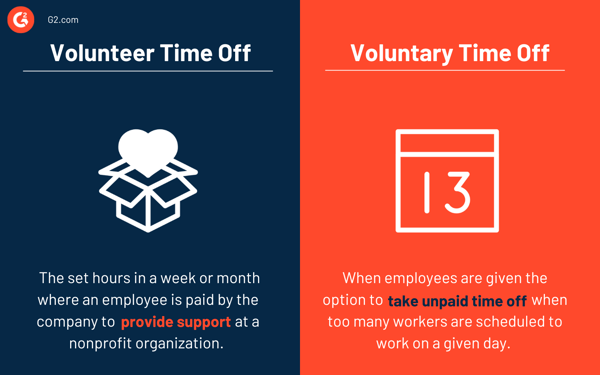February 8, 2024
 by Holly Landis / February 8, 2024
by Holly Landis / February 8, 2024

A good paycheck and standard benefits like health insurance and vacation days aren’t enough to make a company stand out in a competitive hiring market these days.
Additional perks like volunteer time off allow employees to contribute to their community meaningfully, without having to give up their limited outside-of-work hours.
Volunteer time off (VTO) is a work benefit where employees are given paid time off to do service-based work with local non-profit organizations. This may be a set number of hours or days per calendar year where staff can volunteer while being paid as if they were working in their regular role. VTO is separate from other types of paid time off the company offers, like vacation days and sick leave.
VTO is one of the most effective ways to help nonprofits beyond a monetary donation and a good way for businesses to demonstrate their commitment to corporate social responsibility.
Many companies use corporate volunteering software to track and manage their team’s volunteering initiatives. These tools provide insight into the number of hours staff are volunteering, the organizations they’re supporting, and the impact their work is having on local nonprofits.
Not every employee will take up the opportunity to use work hours for volunteering, but those who do enjoy giving back in this way will appreciate the flexibility of being able to support causes they’re passionate about regularly.
The acronym VTO can also be used interchangeably to mean voluntary time off. However, there are some critical differences between these.

Volunteer time off refers to the set hours in a week or month where the company pays an employee to provide support at a non-profit organization.
However, voluntary time off is when employees are allowed to take unpaid time off when too many workers are scheduled to work on a given day. Companies may offer this to balance workloads and staffing, reducing the need to pay additional staff at slower times while still keeping them on the team.
As with other benefits a company offers, VTO comes with financial costs that must be considered. While businesses aren’t losing money in terms of a real line item on the budget, there is some productivity loss to consider as employees will be away from work to complete their volunteering.
of nonprofits need help finding enough skilled volunteers during traditional workday hours.
Source: The University of Maryland
Despite this, several key benefits make offering volunteer time off advantageous for businesses of all sizes.
Individuals looking for a new workplace want to be employed by companies that care about making the world a better place. Further, they want to work for businesses whose company culture and values match their own.
VTO benefits can form a crucial part of the hiring process when looking to recruit top talent. This is especially the case if other businesses in the industry aren’t offering these perks, as additional benefits like VTO can differentiate a company from the competition.
It’s easy to get caught up in the recruiting of new employees, but keeping your existing workforce happy is just as, if not more, important. With increasing costs to hire and train new individuals, retaining your workers is vital for the business’s bottom line and team morale.
Studies have found that corporate charitable actions, both in terms of financial donations and volunteering time, significantly impact the likelihood of team members staying with a company and for how long. Research shows a 52% lower turnover in new employers when VTO is an option.
Businesses are facing strong competition, and not only in hiring. With so many brands for customers to choose from, making more sales and building customer loyalty is essential for long-term success.
Employees volunteering at various organizations in your local area is one of the best ways to get your brand in front of new faces and demonstrate your business’s commitment to supporting the community.
Nonprofits frequently post on social media when volunteers work (even better if the team is wearing company-branded t-shirts in the pictures!), and staff help at public events. This can quickly increase the number of potential customers who are now aware of the business.
Doing something good for others is one of the best feelings, and now it’s been scientifically proven. A study in 2020 found that those who volunteer often rated their lives and overall health better than those who didn’t. Both physical and mental health can be positively impacted by volunteering, depending on the type of work one is doing.
Employees feel a sense of achievement from helping others, and volunteering also offers them the chance to build their skills and learn something new. This can benefit a company in a range of ways, particularly if those new skills, like public speaking and leadership, are transferable to the workplace.
With many nonprofits nationwide and internationally that could use additional help, there are several ways employees can use their VTO benefit based on their personal interests and causes that matter to them.
Whether starting your first company VTO program or revamping an existing one, there are several best practices that businesses should consider following.
The more detailed VTO policies, the better. This prevents any misunderstandings about how VTO works in the business and what needs to be recorded for auditing or reviewing later.
Employees should have a clear understanding of:
Keeping the VTO program as simple as possible is one of the best ways to set your initiative up for success, especially if it’s the first one being attempted. Running a trial program may be beneficial, especially if team members or senior leadership are hesitant to implement an entire program.
Instead of letting employees choose their organizations, working on a company-wide volunteering day for a single organization or cause can be a helpful starting point. If this succeeds, the program can be expanded over time to a more flexible benefit.
Abusing benefits is something everyone hopes their team won’t do, but it’s always a possibility. Particularly for perks that are remote, flexible, and away from the office, the potential for time theft is always there.
By implementing corporate volunteering platforms to track and manage employee VTO, all details can be recorded on who is volunteering, where, and when. This makes it easier for HR to ensure employees are completing their volunteering work as expected and keeping track of these hours separately from other time off like vacation or sick days.
It’s essential to share information about new VTO benefits or any updates to an existing program with the whole team, particularly at larger organizations.
Creating a shared digital file with documentation about VTO, sending information emails, or even creating instructional videos on how to use this benefit are all options for sharing these details company-wide.
Volunteering tracking software helps businesses increase their employee engagement and participation in charitable programs and events.
To be included in the corporate volunteering platform category, software must:
* Below are the top 5 leading corporate volunteering platforms from G2’s Winter 2024 Grid® Report. Some reviews may be edited for clarity.
Alaya is a corporate volunteering platform that makes it easy for businesses to create volunteering opportunities for their employees and track the results of charitable activities.
“The platform is user-friendly, and it was straightforward to add the different NGOs and upload their missions to the platform. The NGOs and their missions were then well presented for the volunteers to make their selection and register for their favorite mission. The Alaya team is also very professional and was always available in case of doubts.”
- Alaya by Benevity Review, Emmanuelle S.
“The registration process is not very simple for the NGOs, and sometimes they struggle with the technicalities. Not every NGO is tech-savvy. It will be very helpful if it is easy to register or if someone can handhold an NGO during the registration process.”
- Alaya by Benevity Review, Sunita B.
Chezuba personalizes volunteering data for employees in a gamified system to encourage participation. New opportunities are searchable, while dashboards provide data visualization for leadership to review company-wide volunteering metrics
“I've always been a fan of volunteering work but struggled to find relevant opportunities. Chezuba made it so easy! They have a wide variety of activities to choose from. The detail on skill-based volunteering projects is just incredible, and I love that they have non-profit partners in 100+ countries.”
- Chezuba Review, Carrie C.
“I wish they had more opportunities in the area of accounting and skill building.”
- Chezuba Review, Ravi K.
Millie is a social impact platform that allows businesses to manage in-person and remote corporate volunteering opportunities. Features of the tool include employee donation matching capabilities, charitable campaign builders, affinity groups, volunteering databases, and analytics.
“Millie is an amazing application that makes donating and volunteering easy and satisfying. It has allowed me to give our employees a way to organize fundraising for causes they care about in a simple way while still being able to track data and see what drives engagement. Their customer service is easily accessible, and it is truly a company full of people who care about supporting non-profits. It is easy to integrate into Slack, and that makes a huge difference.”
- Millie Review, Amber B.
“The interface is a little hard to use. If a charity I support doesn't show up, I just have to send the receipts to my Corporate Social Responsibilities director to vet it.”
- Millie Review, Andrea P.
Deed provides employees with a user-friendly experience around volunteering, giving, and everyday actions that make the world a better place. This end-to-end cross-platform meets employees where they live, and the cutting-edge community features help support an inclusive and purpose-driven culture.
“The platform is what I enjoy the most about Deed. It is simple to use, intuitive, colorful, and direct. I particularly appreciate how it is organized into three sections: money-giving, volunteering, and staff involvement.”
- Deed Review, Sai Kumar M.
“The thing that I like the least about Deed is the integration with other platforms. We use different tools to do our day-to-day activities, and to integrate them with Deed, you have to get in touch with a representative instead of just doing the integration through the platform.”
- Deed Review, Nicolas G.
Selflessly is all-in-one software to help the HR team and other people leaders create transformative workplace cultures of giving and corporate social responsibility (CSR).
“Really love how easy it is to log and track impact, including how it automatically sends the donations to the business for matching. It’s truly a one-stop shop.”
- Selflessly Review, Kim E.
“I wish there were automated ways to periodically remind my team they have matching funds available.”
- Selflessly Review, Stacey B.

Whether employees choose to take up the opportunity of volunteering or not, providing company-approved volunteer time off has numerous internal and external benefits. And the ones who choose to give some of their time back to the community, can feel good knowing that their efforts have made a difference.
Find a non-profit organization that aligns with your business values and goals and set your employees up for successful volunteering opportunities.
Holly Landis is a freelance writer for G2. She also specializes in being a digital marketing consultant, focusing in on-page SEO, copy, and content writing. She works with SMEs and creative businesses that want to be more intentional with their digital strategies and grow organically on channels they own. As a Brit now living in the USA, you'll usually find her drinking copious amounts of tea in her cherished Anne Boleyn mug while watching endless reruns of Parks and Rec.
Oh no, I am late for the meeting. Again.
 by Lauren Pope
by Lauren Pope
As someone who’s walked the tightrope of being both a freelancer and has managed freelancers...
 by Keerthi Rangan
by Keerthi Rangan
Time tracking is essential for business and employee success because it helps eliminate...
 by Ankur Dhingra
by Ankur Dhingra
Oh no, I am late for the meeting. Again.
 by Lauren Pope
by Lauren Pope
As someone who’s walked the tightrope of being both a freelancer and has managed freelancers...
 by Keerthi Rangan
by Keerthi Rangan

